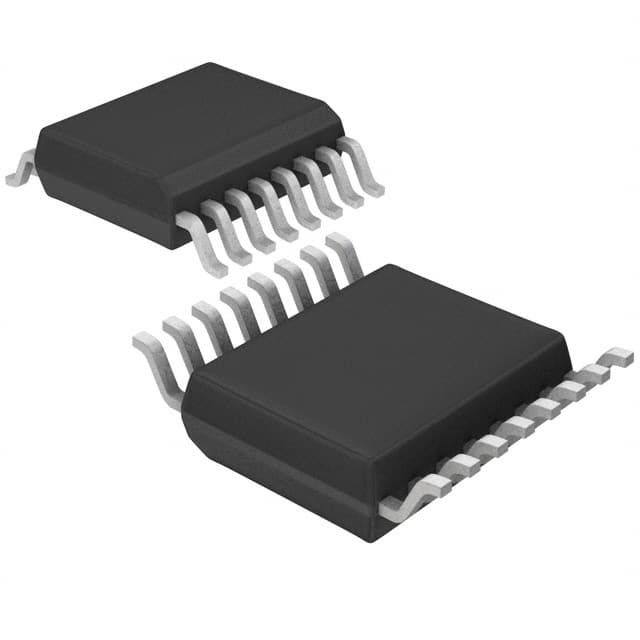SN74BCT374DBR
Product Overview
Category
SN74BCT374DBR belongs to the category of integrated circuits (ICs).
Use
It is commonly used as a flip-flop latch in digital electronic circuits.
Characteristics
- High-speed operation
- Low power consumption
- Wide operating voltage range
- Schmitt-trigger inputs for noise immunity
- 3-state outputs for bus-oriented applications
Package
SN74BCT374DBR is available in a small-outline integrated circuit (SOIC) package.
Essence
The essence of SN74BCT374DBR lies in its ability to store and transfer data in digital systems.
Packaging/Quantity
SN74BCT374DBR is typically packaged in reels, with each reel containing a specific quantity of ICs. The exact quantity may vary depending on the manufacturer.
Specifications
- Supply Voltage: 4.5V to 5.5V
- Operating Temperature Range: -40°C to +85°C
- Output Current: ±24mA
- Input Voltage Range: 0V to VCC
- Propagation Delay Time: 7ns (typical)
Detailed Pin Configuration
SN74BCT374DBR has a total of 20 pins, which are assigned specific functions. The pin configuration is as follows:
- D0: Data input 0
- D1: Data input 1
- D2: Data input 2
- D3: Data input 3
- D4: Data input 4
- D5: Data input 5
- D6: Data input 6
- D7: Data input 7
- GND: Ground
- Q7: Output 7
- Q6: Output 6
- Q5: Output 5
- Q4: Output 4
- Q3: Output 3
- Q2: Output 2
- Q1: Output 1
- Q0: Output 0
- OE: Output enable
- CP: Clock pulse input
- VCC: Supply voltage
Functional Features
SN74BCT374DBR offers the following functional features:
- Data storage and transfer using flip-flop latch mechanism
- Schmitt-trigger inputs for improved noise immunity
- 3-state outputs for bus-oriented applications
- High-speed operation for efficient data processing
- Low power consumption for energy efficiency
Advantages and Disadvantages
Advantages
- High-speed operation allows for quick data processing.
- Low power consumption helps in reducing energy usage.
- Wide operating voltage range provides flexibility in various applications.
- Schmitt-trigger inputs enhance noise immunity, ensuring reliable data transfer.
- 3-state outputs enable efficient bus-oriented applications.
Disadvantages
- Limited number of output pins may restrict certain complex circuit designs.
- Propagation delay time may affect real-time applications requiring immediate response.
Working Principles
SN74BCT374DBR operates based on the principles of flip-flop latch. It stores and transfers data using clock pulses and enables or disables the output based on the control signal. The Schmitt-trigger inputs ensure stable and reliable data input, while the 3-state outputs allow multiple devices to share a common bus.
Detailed Application Field Plans
SN74BCT374DBR finds applications in various digital electronic systems, including but not limited to: - Microcontrollers - Data storage devices - Communication systems - Industrial automation - Automotive electronics
Detailed and Complete Alternative Models
Some alternative models that offer similar functionality to SN74BCT374DBR are: - 74HC374: High-speed CMOS logic IC - CD74HCT374: High-speed CMOS logic IC with Schmitt-trigger inputs - SN54BCT374: Bipolar TTL logic IC
These alternative models can be considered based on specific requirements and compatibility with the existing system.
Word count: 511
قم بإدراج 10 أسئلة وإجابات شائعة تتعلق بتطبيق SN74BCT374DBR في الحلول التقنية
Sure! Here are 10 common questions and answers related to the application of SN74BCT374DBR in technical solutions:
Q: What is SN74BCT374DBR? A: SN74BCT374DBR is a type of octal D-type flip-flop integrated circuit (IC) that can store and transfer data in digital systems.
Q: What is the purpose of SN74BCT374DBR? A: SN74BCT374DBR is commonly used for data storage, data transfer, and synchronization in various digital applications.
Q: What is the maximum operating voltage for SN74BCT374DBR? A: The maximum operating voltage for SN74BCT374DBR is typically 5.5 volts.
Q: How many flip-flops are there in SN74BCT374DBR? A: SN74BCT374DBR consists of 8 individual D-type flip-flops, making it an octal flip-flop IC.
Q: What is the output current capability of SN74BCT374DBR? A: SN74BCT374DBR has a typical output current capability of ±24 mA.
Q: Can SN74BCT374DBR be used in both synchronous and asynchronous applications? A: Yes, SN74BCT374DBR can be used in both synchronous and asynchronous applications depending on the design requirements.
Q: What is the propagation delay of SN74BCT374DBR? A: The propagation delay of SN74BCT374DBR is typically around 9 ns.
Q: Is SN74BCT374DBR compatible with TTL logic levels? A: Yes, SN74BCT374DBR is compatible with both TTL and CMOS logic levels, making it versatile for various digital systems.
Q: Can SN74BCT374DBR be cascaded to increase the number of flip-flops? A: Yes, multiple SN74BCT374DBR ICs can be cascaded together to increase the number of flip-flops in a system.
Q: What are some common applications of SN74BCT374DBR? A: SN74BCT374DBR is commonly used in applications such as data registers, address latches, counters, shift registers, and memory units.
Please note that the answers provided here are general and may vary depending on specific datasheet specifications and application requirements.


